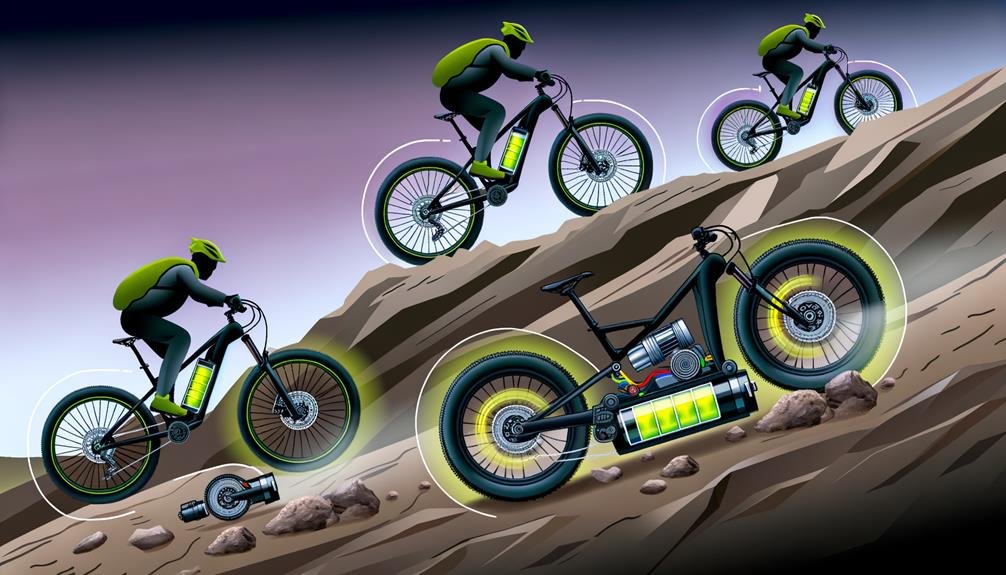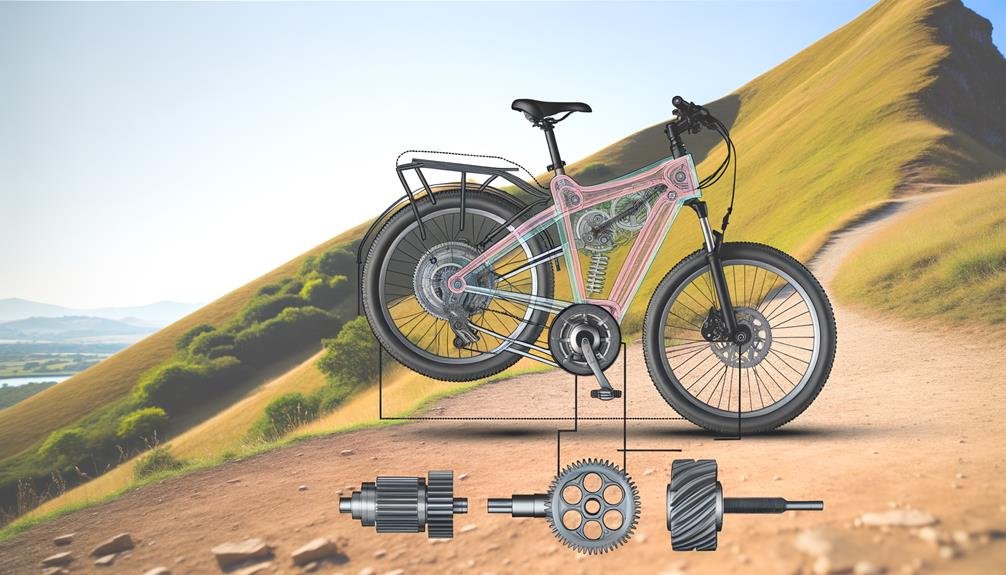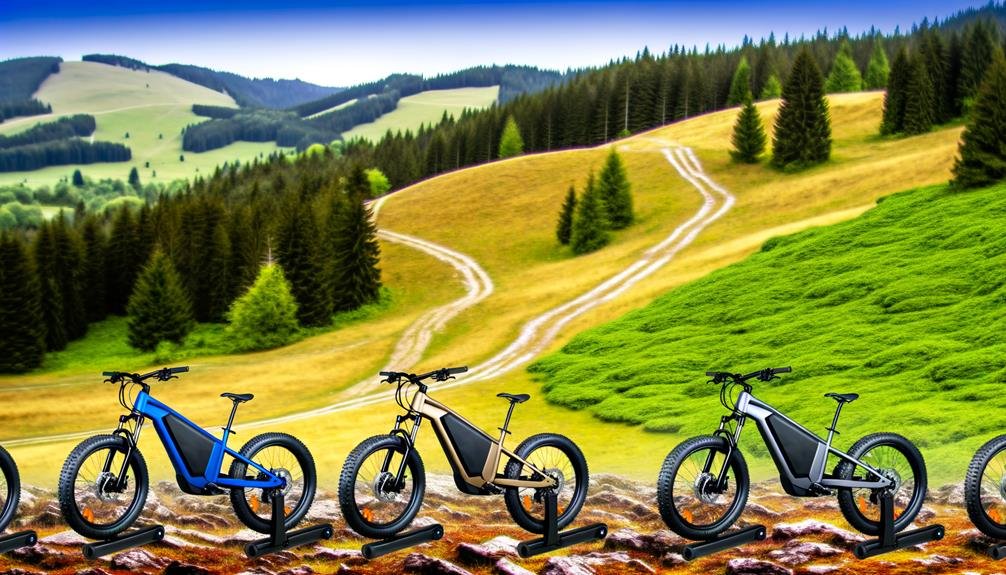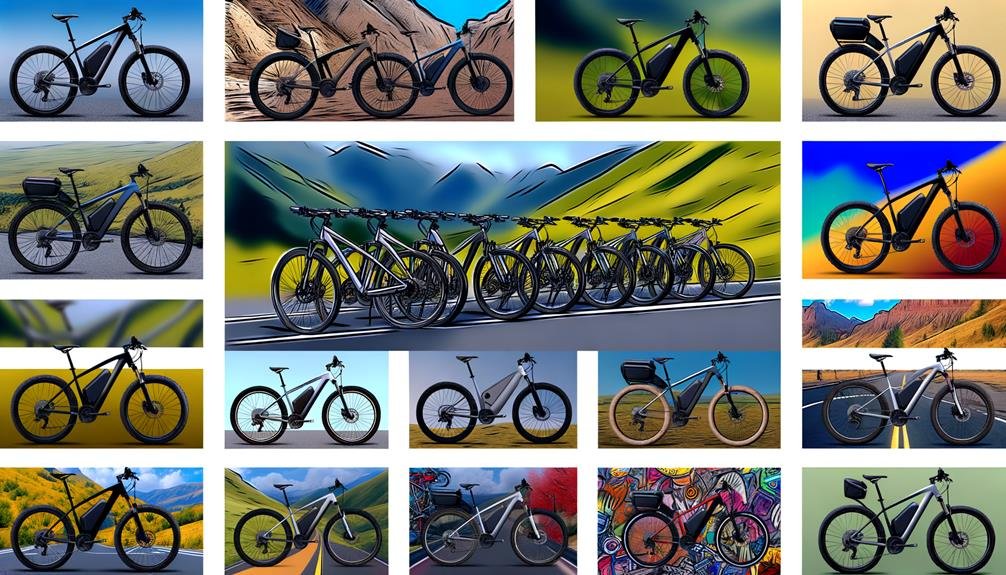Charles Miller is a veteran bike enthusiast with over 12 years of experience dealing with bikes as a mechanic. Despite immense love and expertise for...
Isn't it a challenge trying to find the perfect electric bike capable of conquering those steep hills? Well, we're here to navigate this tricky terrain with you.
As we venture into this discussion, we'll consider crucial factors such as the e-bike's motor power, battery lifespan, gear systems, and even the quality of its brakes.
We'll sift through the technical jargon, making it easier for you to understand what really matters when choosing an e-bike for hilly commutes.
Stay with us, as the journey we undertake together may just lead you to your ideal hill-climbing companion.
- Key Takeaways
- Understanding Hill-Climbing Challenges
- Benefits of Electric Bikes
- Essential E-Bike Features
- Power and Performance Analysis
- Evaluating Battery Life and Range
- Gear Systems Examination
- Frame and Suspension Considerations
- Top Electric Bike Recommendations
- Frequently Asked Questions
- Conclusion
Key Takeaways
- Power and torque are critical for conquering hills
- Battery life directly influences the range of the e-bike
- Larger capacity batteries are better for hilly terrains
- Gear ratios and suspension systems enhance performance on hills
Understanding Hill-Climbing Challenges
Navigating uphill terrain poses a unique set of challenges for e-bikes, as it places increased demand on both the motor and battery, subsequently affecting their range and performance. As we delve into the complexities of hill climbing, it's crucial to understand that the weight of the rider and the e-bike itself can impact the efficiency of the ascent.
Power and torque are critical elements in conquering challenging terrains. The best electric bikes designed for hill climbing often boast high torque and a mid-drive motor. This combination allows for optimal gear ratios, maximizing the bike's power output.
Beyond the mechanics, a bike's suspension and frame design play a significant role in providing comfort and stability during hill climbs. A well-designed frame can help distribute the bike's weight evenly, improving overall maneuverability and control.
To identify the best electric bikes for hill climbing, we must analyze these factors in unison. It's about finding a bike that not only conquers challenging terrains but also ensures a comfortable and controlled ride. This comprehensive understanding of hill-climbing challenges helps us feel more connected and informed within the e-bike community.
Benefits of Electric Bikes
Having dissected the intricacies of hill climbing with e-bikes, it's equally important to shed light on the manifold benefits these innovative machines offer. Electric bikes, particularly those equipped with mid-drive motors, prove to be the best for hills and provide a host of advantages beyond just conquering ascents.
- Versatility: E-bikes enable us to venture into hilly landscapes with ease. This expands our outdoor exploration possibilities, fostering a sense of belonging with nature and fellow riders.
- Efficiency: Electric bikes save time and energy, making hill climbing accessible to beginners or those less physically able. This feature can be a game-changer for people wanting to enjoy the thrill of climbing hills without excessive strain.
- Health and Sustainability: E-bikes contribute to improved fitness and cardiovascular health. Moreover, they're a green alternative, reducing our carbon footprint and promoting sustainable living.
Essential E-Bike Features

When it comes to e-bikes for hills, certain features take on heightened importance.
The power of the motor, for instance, directly impacts the level of assistance provided during uphill rides.
Meanwhile, battery life determines how long we can ride without recharging.
The bike's terrain handling capabilities, including gear systems and braking, are vital for a smooth, controlled hill climb.
Power of Motor
In choosing an electric bike for hilly terrains, the power and performance of the motor emerge as critical factors. The power of the motor directly impacts the bike's ability to tackle hills, providing the necessary power boost to ascend steep inclines.
- Torque: This is the twisting force that makes your bike move. More torque means more power to conquer steep hills.
- Watts: The motor's power is measured in watts. We suggest opting for e-bikes with a minimum of 250 watts for hill climbing.
- Power Boost: This feature provides an extra surge of power when tackling steep hills.
Therefore, whether you're commuting or exploring, the right electric bike with a powerful motor can make tackling hills a breeze.
Battery Life Importance
Let's delve into another crucial aspect of electric bikes for hills – the battery life, a determining factor that directly influences the range your e-bike can cover, especially during those challenging hill climbs. This is where the battery life importance comes in. The best e-Bikes with long-lasting batteries offer consistent power delivery, even when tackling steep inclines and require less frequent recharging.
Here's a brief overview:
| Aspect | Details | Importance |
|---|---|---|
| Range | Directly linked with battery life | Crucial for hill climbs |
| Torque | Measured in (Nm), relies on battery | Powers uphill rides |
| Convenience | Removable batteries for easy charging | Enhances user experience |
Terrain Handling Capabilities
Navigating challenging terrains requires more than just a powerful motor and a long-lasting battery; it's the bike's terrain handling capabilities that truly make the difference.
When it comes to electric mountain bikes, particularly those adept at climbing, three features are crucial:
- Motor Power: A robust motor provides the necessary torque to tackle steep inclines.
- Full Suspension: This feature smoothens out bumps, enhancing comfort and control on rough trails.
- Optimized Gear Systems: They ensure efficient power transfer, making uphill rides less strenuous.
These aspects collectively enhance an e-bike's terrain handling capabilities, paving the way for an effortless hill climb.
Therefore, while choosing your e-bike, it's essential to consider the harmony of these features to guarantee a seamless riding experience, irrespective of the landscape's complexity.
Power and Performance Analysis

Let's turn our attention to the power and performance of electric bikes for hills.
Beginning with torque specifications, evaluating the torque output is essential as it directly impacts the bike's ability to climb steep terrains efficiently.
We'll also consider hill climb efficiency, which relates to how effectively the combination of motor power, battery capacity, and gear system works together to conquer challenging slopes.
Torque Specifications
When evaluating the power and performance of electric bikes for hill climbing, it's the torque, a measure of rotational force, that plays a crucial role.
Here's why torque specifications matter:
- The torque of an electric bike's motor determines if it's powerful enough to conquer steep inclines.
- Higher torque values enable the bike to maintain speed and power while climbing hills.
- Understanding the torque specifications of different bike models helps in choosing the best one for hill riding.
Ultimately, the best electric bike for hills is one with a high torque motor. It's not just about getting to the top, it's about belonging to a community of riders who value power, performance, and the thrill of the climb.
Hill Climb Efficiency
Diving into the analysis of power and performance, we find that the hill climb efficiency of an electric bike hinges on several key factors, including the robustness of the motor, the longevity of the battery, the reliability of the gear system, and the overall comfort and safety provided by the frame and suspension.
To illustrate, let's look at some examples:
| Electric Bike | Key Features |
|---|---|
| Aventon Level.2 | 500W rear hub motor, 42-mile range |
| Rad Power RadCity 5 Plus | 750W rear hub motor, 30-mile range |
| Specialized Turbo Vado 5.0 | 250W mid-drive motor, 50-mile range |
These bikes show how a more robust hub motor can provide the extra power needed for hill climbing. A reliable gearing system, meanwhile, ensures the energy from the motor is efficiently used.
Evaluating Battery Life and Range
In order to tackle hills and long rides, it's vital to scrutinize the battery capacity and type of your e-bike. Evaluating battery life and range isn't merely about the initial charge, but also how effectively the e-bike manages that power, especially when climbing hills.
- Battery Capacity and Type: Not all batteries are created equal. Some e-bike batteries are designed for longer rides, while others prioritize quick bursts of speed. For hilly terrains, you'll want a battery with a larger capacity and a type that can handle the sustained power output.
- Range: The range of an electric bike is the distance it can travel on a single charge. Hills can significantly reduce this distance, so always factor in the type of terrain you'll be riding on when looking at an e-bike's range.
- Battery Management System: A good battery management system ensures optimal energy efficiency, which is crucial for maintaining power on long, uphill rides. It should also factor in the recharging time and availability of charging stations.
Gear Systems Examination

Beyond carefully considering battery life and management, it's equally crucial to turn our attention to the e-bike's gear systems, as this can significantly impact its ability to navigate hilly terrains. When considering buying an electric bike, a thorough gear systems examination can provide key insights into the bike's capabilities.
Understanding gear ratios and the number of gears a bike offers can tell us a lot about its performance on hills. A higher gear ratio and more gears generally indicate enhanced hill climbing ability. Similarly, the gear range and the presence of low gears are essential for conquering steep inclines.
| Aspect | Importance |
|---|---|
| Gear Ratio | Determines speed and power |
| Number of Gears | Offers versatility |
| Gear Range | Enables tackling steep inclines |
| Gear Shifting Mechanism | Affects ease of use |
The gear shifting mechanism and its ease of use are equally important. Smooth gear shifting ensures a comfortable ride, especially on hilly terrains. Lastly, we must consider the system's durability and performance under load. This ensures that your electric bike can withstand the rigors of uphill cycling. With this knowledge, you're one step closer to finding the perfect e-bike for hills.
Frame and Suspension Considerations
Shifting our focus to frame and suspension considerations, it's crucial to remember that the material and design of the frame play a significant role in ensuring an e-bike's suitability for hill climbing.
- Frame Material and Design: Durability and strength are key for an electric bike tackling hills. Lighter materials like aluminum alloys are often used in quality mountain bikes for their blend of strength and lightweight attributes.
- Suspension Systems: E-bikes with full suspension or front suspension provide a smoother, more comfortable ride. Adjustable settings enable customization to the rider's preferences and hill conditions. Some suspension systems even feature lockout options to optimize efficiency when climbing hills or on flat terrains.
- Frame Geometry: The layout of the frame significantly affects stability and control on hilly terrains. Look for designs that place the rider's weight centrally for better balance.
Now, don't forget the tires! Fat tires can provide extra traction and shock absorption, enhancing control and comfort on hills.
Top Electric Bike Recommendations

After considering the importance of frame and suspension in e-bikes for hill climbing, let's now turn our attention to some excellent electric bike recommendations that excel in these areas and more. We've narrowed down the best bikes to three key contenders that are contextually relevant and highly rated for tackling hills.
| Electric Bike | Key Features |
|---|---|
| Aventon Level 2 | 500W rear hub motor, range of 42 miles |
| Rad Power RadCity 5 Plus | 750W rear hub motor, range of 30 miles, 20mph top speed |
| Specialized Turbo Vado 5.0 | 250W mid-drive motor, range of 50 miles, 28mph top speed |
The Aventon Level 2 offers a powerful motor and impressive range, making it ideal for tough climbs. If speed is a priority, the Rad Power RadCity 5 Plus reaches up to 20mph, while the Specialized Turbo Vado 5.0 tops at 28mph, perfect for high-speed hill climbing. Lastly, let's not forget the Hovsco Electric Bikes specifically designed for hills. Choose the right one based on your needs and belong to the community of electric bike enthusiasts conquering every hill.
Frequently Asked Questions
Are Electric Bikes Good for Going up Hills?
We've found that electric bikes excel in hill performance due to their motor power, gear functionality, and terrain adaptability. They're also good for battery longevity, making uphill journeys more manageable and enjoyable for us.
Are Electric Bikes Any Good on Hills?
We've found that electric bikes excel on hills. Their hill performance, battery efficiency, and motor strength easily handle climbing angles and torque requirements, making hilly routes a breeze rather than a workout.
What Is the Best Ebike for Hilly Cities?
We believe the best e-bike for hilly cities balances hill-specific features, battery life, torque vs. power, suspension systems, and gear shifting mechanisms. It's all about combining comfort, power, and durability for those challenging climbs.
Which Bike Is Best for Hill Climb?
We believe optimal gears usage, e-bike battery efficiency, hill climbing techniques, suspension importance, and tire selection all impact which bike is best for hill climbs. It's about matching your needs to the bike's capabilities.
Conclusion
In conclusion, finding the perfect e-bike for tackling hills is a steep task. It's a balancing act between power, performance, gear systems, and battery life. However, with thoughtful consideration of your unique needs, you'll find the ideal machine to conquer any peak.
Whether it's the rugged Aventon Level.2 or the high-powered RadCity 5 Plus, your journey up won't just be a ride, it'll be a triumphant ascent. Remember, every hill is just a new opportunity for adventure.

Charles Miller is a veteran bike enthusiast with over 12 years of experience dealing with bikes as a mechanic. Despite immense love and expertise for his Tacoma, he rides his Trek Ebike more. Anytime you meet him, you’ll either hear him talking about Bikes, or writing about all things bikes and cars on this blog.
More Posts


